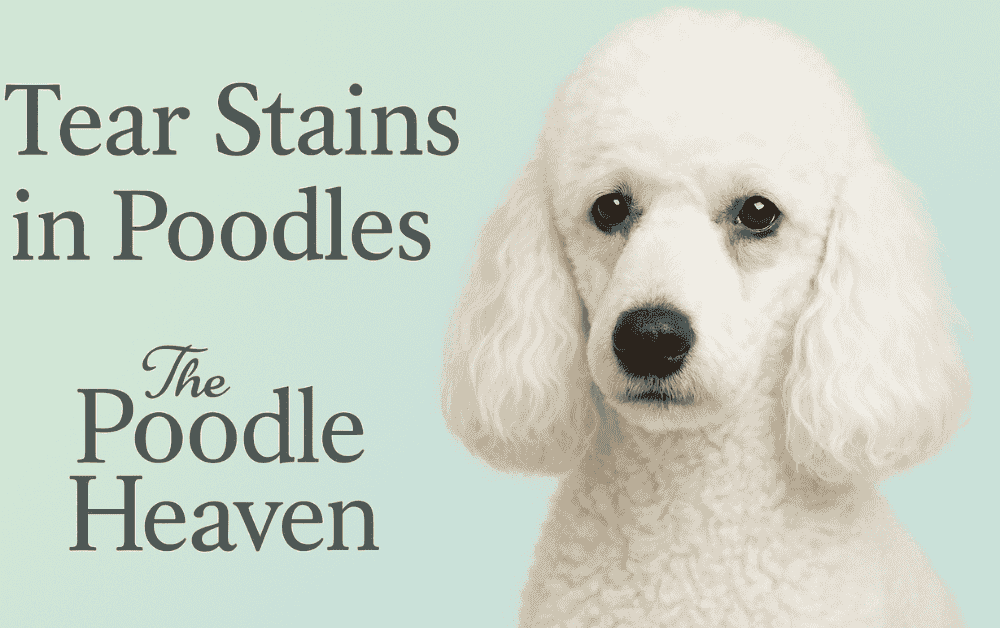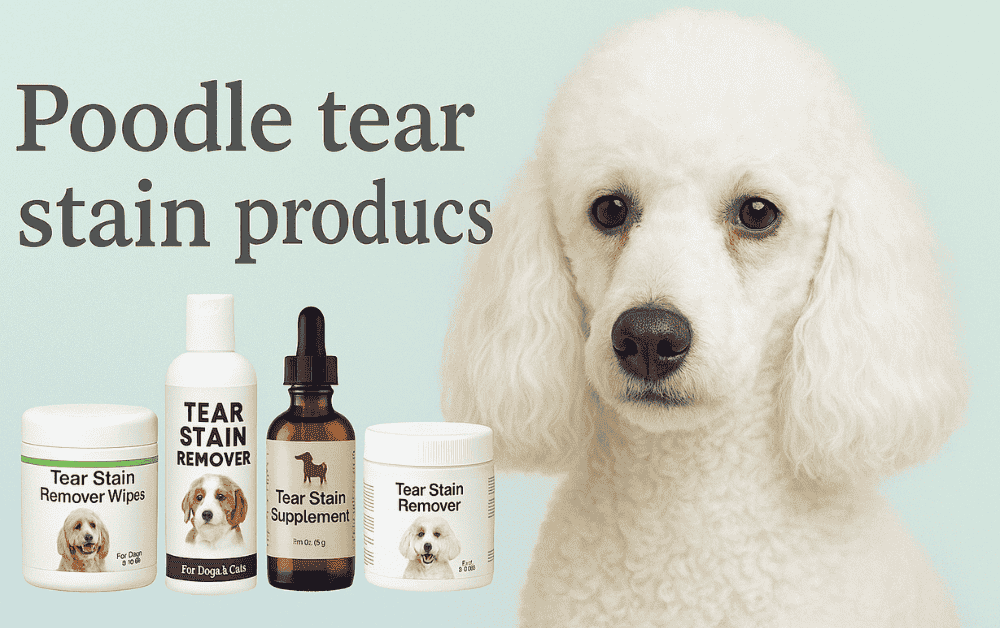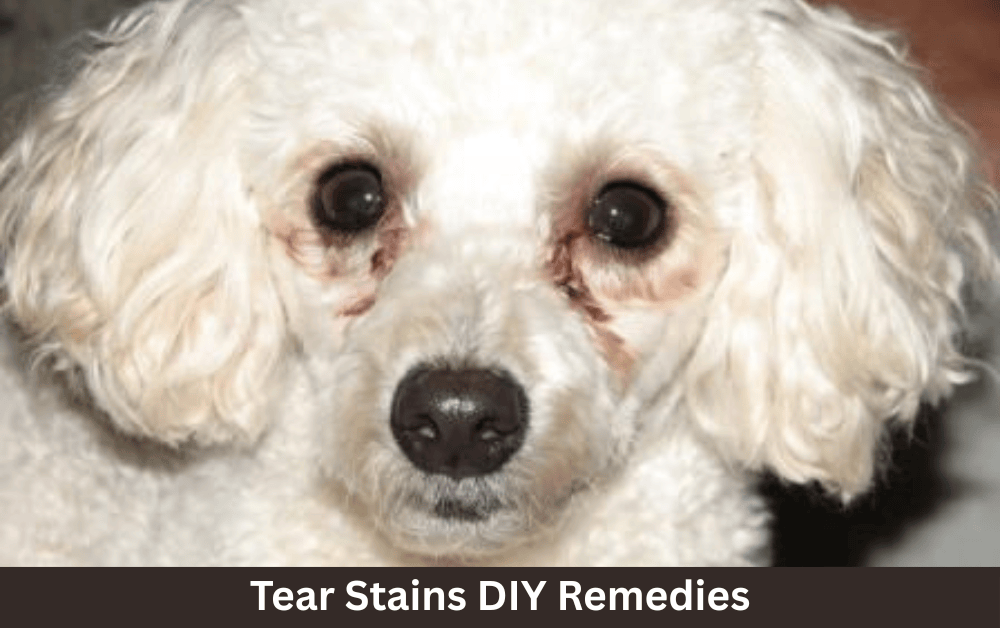Understanding Tear Stains in Poodles
Poodles often get tear stains more than other breeds. Their curly fur traps moisture and makes it harder for the skin to stay dry. Also, some Poodles have shallow eye sockets or small tear ducts, which causes tears to overflow. Miniature and Toy Poodles tend to have this problem more often than Standard Poodles. If owners don’t clean the face daily, the moisture can lead to tear stains and even skin infections.
How to Identify Tear Stains?
Signs of Tear Staining:
- Dark red or brown marks under the eyes
- Wet or damp fur on the cheeks
- Crusty build-up around the eyes
- Bad smell from the stained area
- Discoloration that doesn’t go away with regular cleaning
According to the American Kennel Club (AKC), ongoing tear stains may point to health problems like blocked tear ducts or allergies. If the tearing doesn’t go away after cleaning and grooming, you should talk to your vet to rule out a bigger issue.
Common Causes of Tear Stains in Poodles

- Anatomical Traits
- Overactive Tearing (Epiphora)
- Blocked Tear Ducts
- Eye Infections
- Allergies
- Diet and Water Issues
- Yeast/Bacterial Infections
Anatomical Traits
Poodles’ shallow eye sockets and tight facial skin often prevent tears from draining properly. Instead, tears spill onto the fur. Their long hair around the eyes worsens the problem by trapping moisture and encouraging bacterial growth.
Overactive Tearing (Epiphora)
When irritants like dust, smoke, or wind bother your Poodle’s eyes, they produce extra tears to flush them out. These excessive tears soak the fur and lead to stains over time.
Blocked Tear Ducts
Tear ducts normally drain tears into the nose. In Toy and Miniature Poodles, these ducts often clog or narrow, forcing tears to overflow onto the face. The constant wetness creates ideal conditions for staining.
Eye Infections
Infections from bacteria, scratches, or poor grooming trigger increased tear production. Watch for redness, swelling, yellow discharge, or excessive blinking—all signs your Poodle’s eyes are fighting an infection.
Allergies
Like humans, Poodles suffer from food or environmental allergies (pollen, dust, mold). The American Kennel Club notes that these allergies are a top cause of miniature poodle tear stains. Watery eyes from allergies keep the fur perpetually damp.
Diet and Water Issues
Low-quality kibble with fillers, artificial dyes, or grains can worsen staining. Tap water high in iron or minerals also contributes. Switching to filtered water and a high-protein, balanced diet often helps reduce stains.
Yeast/Bacterial Infections
Damp fur beneath the eyes creates a breeding ground for yeast (like Malassezia) or bacteria. These infections cause dark, sticky stains and a distinct, unpleasant odor.
Quick Tip:
“Gently wipe your Poodle’s face daily with a soft, damp cloth to remove excess tears and prevent bacterial buildup. For stubborn stains, use a vet-approved tear stain remover—but avoid products with harsh chemicals!”
When should you consult a veterinarian for poodle staining?
Most standard poodle tear stains are harmless and can be treated at home. But sometimes, the stains won’t go away or get worse. If that happens, you should see a vet. Here’s when you should seek professional help:
Persistent or Worsening Tear Stains
If your standard poodle’s tear stains don’t improve after cleaning or get darker and more frequent, it’s time to call the vet. Sometimes, a simple cleaning routine isn’t enough, and there may be a hidden problem.
Accompanying Symptoms
If your Poodle has tear stains and other signs, like:
- Redness around the eyes
- Swelling or puffiness
- A foul odor is coming from the stained area
- Yellow or green discharge Then it’s a good sign your dog has an infection or other health issue that needs treatment.
Potential Underlying Health Issues
Chronic tear staining can be a sign of a blocked tear duct, allergies, or even an eye infection. The vet can do tests to figure out the root cause. If left untreated, infections or allergies can cause more serious health problems, like vision issues or painful eye conditions.
Step-by-Step DIY Guide to Cleaning Tear Stains in Poodles
Cleaning tear stains is a key part of managing them. If you stay consistent and use the right products, you can reduce the appearance of tear stains and keep your Poodle’s face healthy. Cleaning tear stains from your Poodle’s face doesn’t have to be difficult. With the right tools and a gentle approach, you can keep your dog’s eyes clean and free from stains. Here’s a simple, detailed guide to follow:
Gather Your Supplies
Before you start cleaning, make sure you have everything you need. This includes:
- Tear stain wipes or saline solution
- Soft cloths or cotton pads
- Pet-safe grooming scissors (for trimming hair)
- A clean towel to dry the area
- Disposable gloves (optional, to avoid transferring oils)
Prepare Your Poodle
Find a calm, quiet place to clean your Poodle. You can do this after they’ve had a bath, or when they’re relaxed. If you’re doing this during or after poodle bath time, the moisture will help loosen any buildup, making cleaning easier.
Make sure your Poodle is comfortable before you begin. Keep them still and calm so the process goes smoothly.
Clean the Tear Stains
- Wet a cotton pad or a tear stain wipe with saline solution or a product designed for this purpose. Make sure it’s moist but not soaking.
- Gently press the cotton pad on the stained area, starting at the corner of the eye near the nose, and gently wipe outwards toward the ear. Be sure to avoid getting cleaning solutions directly into their eyes.
- Use gentle motions to avoid irritating your Poodle’s sensitive skin. Don’t scrub—let the solution dissolve any dirt, tears, or crusted buildup.
- If the stain is stubborn, you can rub in small circular motions, but do it very gently.
Trim the Hair Around the Eyes
If there’s long hair near the eyes, it’s important to trim it. This helps prevent moisture from being trapped, which can cause more tear stains.
- Use pet-safe grooming scissors to carefully trim the fur around the eyes. Only trim the fur around the edges, and be very cautious when near the eyes.
- Don’t trim too close to the skin. It’s better to trim a little at a time and check the area frequently. Regular trimming will help keep the area clean and dry.
Dry the Area
After cleaning, it’s crucial to dry the area to prevent moisture from lingering. This will help keep bacteria and yeast from growing, which could lead to infections.
- Use a clean towel to gently pat the area dry. Avoid rubbing, as it may irritate your dog’s skin.
- Make sure the skin around the eyes is completely dry before moving on. Moisture left behind can make the stain worse or lead to further irritation.
Maintain Regular Cleaning
Consistency is key when it comes to managing tear stains. To prevent future stains, make sure to clean your Poodle’s eyes at least 3-4 times a week.
- If you notice more tearing after play or outdoor activities, clean their eyes right away to prevent stains from setting in.
- Make cleaning a regular part of your dog’s grooming routine to keep their eyes healthy and clean.
How to Prevent Tear Stains From Coming Back in Poodles?
- Maintaining Facial Hygiene
- Proper Grooming Practices
- Providing a Balanced Diet and Clean, Filtered Water
- Using Stainless Steel or Ceramic Bowls Instead of Plastic
- Minimizing Exposure to Allergens
Maintaining Facial Hygiene
Keep your Poodle’s face clean by wiping the area around their eyes every day. Use a gentle wipe or saline solution to remove dirt and moisture. Regular cleaning stops tears from staying on the fur too long, which can cause stains.
Proper Grooming Practices
Trim the hair around your Poodle’s eyes regularly. If the fur is too long, it can trap moisture and make the area even wetter. Keeping the hair short helps reduce the chance of bacteria and yeast building up near the eyes.
Providing a Balanced Diet and Clean, Filtered Water
Feed your Poodle a healthy, balanced diet with high-quality dog food. Foods that are low in fillers and artificial ingredients can help reduce allergies and tear stains. Also, make sure your Poodle always has access to clean, filtered water. Avoid tap water with high iron or minerals, as these can contribute to stains.
Using Stainless Steel or Ceramic Bowls Instead of Plastic
Plastic bowls can build up bacteria that can cause irritation and lead to miniature poodle tear stains. Use stainless steel or ceramic bowls, which are easier to clean and won’t irritate your dog’s skin. Always wash the bowls regularly to keep them clean.
Minimizing Exposure to Allergens
Poodles can be sensitive to environmental allergens like pollen, dust, and mold. Keep your home clean and free of dust. If your Poodle has allergies, try to limit their exposure to common triggers. You can also speak to your vet about possible allergy treatments to reduce tear staining.
Recommended Products For Tear Stains

Here are some of the best products to help clean your Poodle’s tear stains:
Tear Stain Wipes
These are easy to use and safe for your Poodle. They are designed to remove stains without irritating the skin. Look for wipes that are free from harsh chemicals and made for sensitive skin. Popular brands like Vet’s Best and Petpost offer reliable wipes that work well for tear stains.
Saline Solution
A simple saline solution (salt water) is a safe and natural way to clean tear stains. It’s gentle and effective at removing debris from around the eyes. You can find pre-made saline solutions or make your own by mixing 1 teaspoon of salt in 1 cup of warm water.
Natural Tear Stain Removers
Some products use natural ingredients like aloe vera, chamomile, or coconut oil. These ingredients are gentle and soothe the skin while cleaning the tear stains. Products like Angel’s Eyes and Petsmile offer natural tear stain removers that can be safe alternatives to chemical-based options.
Poodle Tear Stains Homemade Remedies

If you prefer a DIY approach, here are two common homemade remedies for toy poodle tear stains.
Diluted Hydrogen Peroxide Solution
You can make a mild hydrogen peroxide solution to help clean tear stains. Mix 1 part hydrogen peroxide (3%) with 3 parts water. Use a cotton pad to apply the solution to the stained area. Be very careful not to get the solution into the eyes, and test on a small area first to check for any irritation.
Apple Cider Vinegar
Some dog owners recommend adding 1/2 teaspoon of apple cider vinegar to your Poodle’s water every day. It can help reduce tear stains by balancing the pH level in the body. However, make sure your dog doesn’t mind the taste and that they drink enough water.
How Frequent to Do Poodle Tear Stains Cleaning?
In addition to daily cleaning, make sure you:
- Check for signs of infection regularly (redness, swelling, discharge)
- Trim the hair around their eyes every few weeks to prevent fur from trapping moisture
- Keep your Poodle’s environment clean by removing dust and allergens that can cause irritation
Staying consistent with cleaning and using the right products can make a big difference in reducing tear stains over time. If you don’t see improvement after regular cleaning, it might be time to consult your vet.
Medications (When Prescribed by a Vet)
Sometimes, tear stains can be caused by an underlying infection, bacteria, or other health issues. In such cases, your vet might recommend medication to treat the problem. It’s important to follow your vet’s advice carefully when using medications. Here are the types of medications that may be prescribed:
Tylosin (Only Under Strict Veterinary Guidance)
- Tylosin is an antibiotic that is sometimes used to treat tear stains caused by bacterial infections. However, it should only be given under the guidance of a veterinarian.
- Your vet will decide if your Poodle’s tear stains are due to an infection that requires Tylosin. Never give this medication without a prescription from your vet, as improper use can lead to side effects.
Other Antibiotic or Antifungal Treatments
- If a bacterial or fungal infection is found to be the cause of the tear stains, your vet may prescribe specific antibiotics or antifungal medications.
- These treatments help clear up infections that can lead to constant tearing and staining. Follow the instructions carefully to make sure your Poodle gets the full benefit of the medication.
Dietary Supplements For Poodle Tear Stains
In some cases, tear stains can be influenced by your Poodle’s diet and overall health. Certain dietary supplements and probiotics can help reduce tear stains by improving their digestion, boosting their immune system, and supporting their overall health. However, before adding any new supplement to your Poodle’s routine, it’s important to consult with your vet.
Role of Supplements in Reducing Tear Stains
- Some supplements contain ingredients that can balance your dog’s tear production and help reduce staining. Ingredients like cranberry extract, vitamin C, and omega fatty acids can improve skin health and reduce tear production.
- Supplements that support gut health, like probiotics, can help reduce tear stains if the cause is linked to allergies or digestive issues. An imbalance in gut bacteria can lead to inflammation, which may contribute to excessive tearing.
Examples of Effective Products
- Zesty Paws Tear Stain Bites: These chewable treats are designed to help reduce tear stains by supporting digestive health and skin health. They contain ingredients like cranberry extract, biotin, and omega fatty acids, all of which are known to support healthy skin and reduce inflammation.
- Petpost Tear Stain Supplements: Another popular option, these supplements include natural ingredients like turmeric and cranberry to reduce tear stains and prevent new ones from forming.
Consulting with a Vet Before Introducing New Supplements
- Always consult your vet before introducing any new supplements to your Poodle’s diet. While supplements can help in many cases, they should be used alongside a healthy diet and proper grooming.
- Your vet can recommend the best products for your dog’s specific needs and ensure that the supplements won’t interfere with any other medications or health conditions.
Professional Treatments for Stubborn Tear Stains
When home care isn’t enough, veterinarians offer targeted solutions. These professional treatments address the specific causes behind persistent tear stains, whether they’re due to blockages, eye structure, or health issues. Here’s what you can expect:
Tear Duct Procedures
Some Poodles suffer from blocked tear ducts (dacryocystitis), where tears can’t drain properly. In these cases:
- Flushing: Vets use a sterile solution to clear the blockage, effective in about 75% of cases.
- Surgery: For stubborn blockages, a minor procedure can open or reconstruct the duct.
- Medication: A 7-14 day antibiotic course often follows to prevent infection.
Surgical Corrections
Certain Poodles need surgical help because of their facial structure. The most common issues include:
- Excess skin folds around the eyes
- Abnormally shallow eye sockets
Recovery typically takes 1-2 weeks, with most dogs showing significant improvement.
Prescription Medications
When infections or allergies cause excessive tearing, vets may prescribe:
For infections:
• Antibiotics (7-14 day course)
• Antifungal creams for yeast-related issues
For allergies:
• Daily antihistamines
• Special eye drops to reduce irritation
Conclusion
Tear stains are a common issue for Poodles, but you can manage them with the right care. Clean your Poodle’s eyes regularly, feed them a balanced diet, and provide clean, filtered water to reduce the risk of staining. If you notice tear stains worsening or accompanied by redness, swelling, or odor, consult a vet. A vet can help identify any underlying issues like blocked tear ducts, infections, or allergies, and recommend the best treatment.
Consistency is key to keeping your Poodle’s eyes healthy and free from tear stains. With the right approach, your Poodle can enjoy clear eyes and a stain-free face.
FAQs About Poodle Tear Stains
Can tear stains be eliminated in poodles?
You may not completely eliminate tear stains, but you can reduce them significantly with regular care. Clean your Poodle’s eyes 2 to 3 times a week, feed them a healthy diet, and keep them well-groomed. If tear stains are caused by issues like blocked tear ducts or allergies, treating these problems can help stop the stains from coming back.
Are tear stains harmful to my Poodle’s health?
Tear stains themselves usually don’t harm your Poodle. However, if the stains are caused by an infection, blocked tear ducts, or allergies, those problems can affect your dog’s health. Watch for signs of infection, redness, or swelling. If you notice these symptoms, consult a vet immediately to prevent further issues.
How long does it take to see improvement after treatment?
The time it takes to see results depends on the cause of the tear stains. After starting treatments like cleaning or medication, you should start to see improvement within 7 to 14 days. For more serious issues like blocked tear ducts, it may take several weeks or longer for your Poodle to show noticeable improvement.
Do certain Poodle coat colors show tear stains more prominently?
Yes, lighter-colored Poodles, such as white, cream, or apricot, show tear stains more clearly. The contrast between their light coat and the stains makes them easier to spot. Darker-colored Poodles, like black or brown, may hide the stains better because of the color of their fur.
How do I get rid of tear stains on my Poodle?
To reduce tear stains on your Poodle, follow these steps:
- Use tear stain supplements like Zesty Paws Tear Stain Bites to support eye health.
- Clean eyes regularly: Use tear stain wipes or a soft cloth 2-3 times a week.
- Trim hair around the eyes to prevent moisture buildup.
- Provide a balanced diet and filtered water to minimize staining.
- Consult a vet if stains persist, as blocked tear ducts or infections may be the cause.
Are Poodles prone to tear stains?
Yes, Poodles are prone to tear stains. Their tear ducts may produce excess tears, which can lead to staining around the eyes. Factors like their shallow eye sockets, long fur around the eyes, allergies, and certain health issues can increase the risk. Regular grooming and cleaning can help reduce tear stains, but it’s important to address any underlying health problems if the staining persists.
Why does my dog have tear stains all of a sudden?
If your dog suddenly develops tear stains, it could be due to a few reasons:
- Irritants: Dust, smoke, or chemicals may irritate your dog’s eyes and cause them to tear up more than usual.
- Allergies: Changes in the environment or diet may cause an allergic reaction, leading to excess tearing.
- Infection: Bacterial or fungal infections can cause tearing and staining.
- Blocked tear ducts: A sudden blockage can prevent tears from draining properly, leading to stains.

